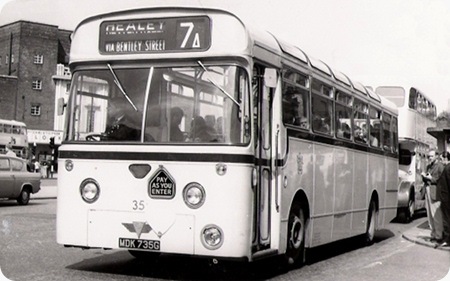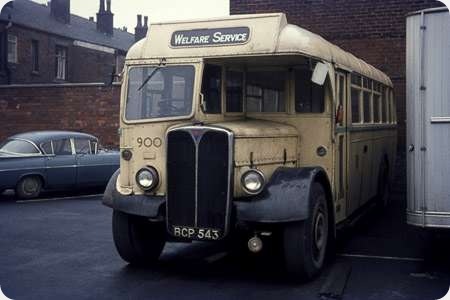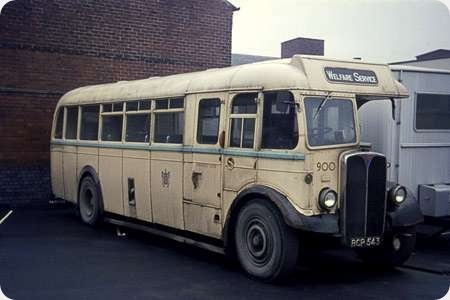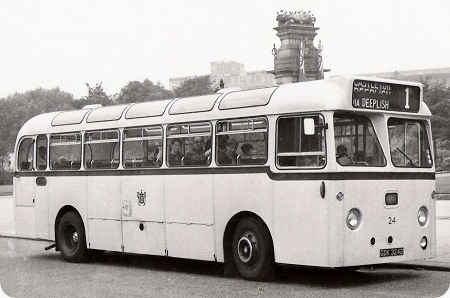
Rochdale Corporation
1969
AEC Swift MP2R
Seddon B46F
My Thanks to Ian Beswick for contributing the above excellent shot of this Rochdale Corporation AEC
Swift with its Seddon body who also supplied bus bodies under the name of Pennine.
The Swift was
AECs move into the rear engined single decker market. It first appeared at the 1964 commercial motor
show and there were two versions a low frame for bus work and a high frame for coach operations.
Operators also had the choice of either the 16ft 6in wheelbase for a vehicle length of 33ft or 18ft 6in
for a 36ft vehicle. The high frame version allowed for luggage to be stored in underfloor side lockers
due to the fact that the rear of the vehicle housed the horizontal six cylinder diesel engine. Yet again
there was a choice of two engines the AH505 ?? litre or the AH691 11·3 litre. London transport acquired
several 36 ft 11·3 litre Swifts which they called Merlings (MB) for some reason best known to them, but
the manoeuvrability was poor so the shorter version (SM) were acquired but due to the shorter length
they had to have the AH508 8·2 litre engine which rendered them well under powered.
Photograph contributed by Ian Beswick
When AEC first announced its rear-engined single deckers, there were to be two
models, the medium-weight Swift with the AH505 engine (33ft or 36ft), and the heavy-duty Merlin with
the AH691 (36ft only). London Transport ordered their Merlins at that stage.
By the time the
two models went into production, they had been harmonised to such a degree that AEC renamed them
Swift 505 and Swift 691. But LT always persisted with the original names.
Peter Williamson
Can someone give technical information on the Swift Chassis, like its length,
weight, width and other information?
Charlie
The Swift was the first joint production with Leyland after the 1962
"merger".
The main chassis frame, and other components, were common to the Swift
and the Panther. The engines and axles were unique to each respective model.
There was a
32’6" (AH505) model (Leyland was the Panther Cub with 0.400 engine). There was a 36’0"
long (AH505 or AH691) model (Leyland was the 0.600 Panther).
All were 8’2½" wide. There
was the most common bus version with a lower front frame and the high frame model intended for coach
work. In the event, no AEC Swifts were built with high frames but there were a number of high frame
Panthers, some with 0.680 engines.
David Oldfield
Does anybody by chance know the weight of the AEC SWIFT AH505 Chassis?
Charlie
13/02/12 - 07:18
I once worked with a former London Transport engineer, who told me how Merlins
were constantly being reported for defective engine stops. Quite often the true explanation turned
out to be that the awful engine had worn its cylinder bores oval, so the bus was actually burning
its own sump oil which was leaking past the piston rings! No good cutting off the diesel if that
isn’t what’s burning…!
And, I once attended a Traffic Commissioner’s hearing in
Southampton where Bill Lewis, then General Manager, responded to a question about the Southampton
Swifts by saying: "If only someone would make me an offer for them!". Not one of AEC’s
best efforts!
David Jones
21/04/12 - 11:38
I had a couple of holidays in South Australia in the mid 90s where I saw many
ex Adelaide Swifts in various guises. Their were some in a yard at Port Adelaide being converted for
further use. In Port Pirie the local bus company had about 6 in use. There was one on town service
in Port Lincoln. One at Port Kenny as a caravan which had a Hino engine a popular conversion with
mobile home conversions. A further mobile home in North Adelaide. Another in Woolaston near Gawler.
In a Marina at Port Adelaide I found one in use as a support vehicle for a film company who had four
more in stock for the same purpose all still with their AEC engines, one of which had just returned
from filming a documentary in the out back doing many miles off road. I read a couple of years ago
the some Swifts had been refurbished and sold to a mining company on an island in Indonesia for
staff transport. All this info suggests that the poor reputation of the Swifts might be
unjustified.
Ron Stringer
21/07/12 - 12:19
As an enthusiastic operator of AEC’s Swift. I find it difficult to imagine how
a few operators apparently had so much trouble with them. From working for an independent who
acquired nine of them second hand … and with more to put into service had he not passed away,
to running four of my own, I found them excellent, reliable and economical work-horses. Any
mechanical maladies were easily attended to as everything was practically laid out in typical AEC
fashion. There are few more challenging bus operating areas than North Staffordshire with it’s mix
of dense urban environment and steep hills. All ours were 505 powered which generally allowed 10mpg
on service and any feeling of being underpowered was usually attributable to a stretched accelerator
cable in my experience. Were I still operating today, I’d have no hesitation in having one around as
a spare bus … indeed I share a preserved one. (ps. The 505 was generally regarded as being
just under 8.2 litres swept volume and had power outputs up to about 160bhp)
Martyn Hearson
20/03/14 - 17:37
Happened on this site purely by accident. In no way consider myself a bus
enthusiast. Rootes Classic cars are my scene.
But many of the photos on this site have
stirred up some vivid childhood memories from growing up in Alkrington, Middleton on the 17
Manchester / Rochdale route.
Like - how immaculate the Rochdale buses on this route always
were. Loved the blue/cream livery and the deep blue seats. AND on this route were Lady Conductors!
Unheard of in Manchester. As a 10 yo I developed a hopeless crush on one particularly pretty chatty
girl and it was a thrill when she came along to issue the ticket.
I’m pretty sure that this
route 17 and the 24 to Rochdale via Broadway/Royton are two of very few to have retained their
original route numbers to the present day since WW2 and maybe before. The 17 was certainly the tram
route number way back when (not that I remember that far back!)
Paul Blackwell
21/03/14 - 17:58
Yes, the 17 has a very long history and as a bus service it has the longest
possible history of using the same number in Manchester, as it dates from the introduction of route
numbering in 1930 although at that point it was an express service from Bacup to Flixton. It took
its current form in 1932.
Whilst there are several routes that have remained essentially the
same for many years, the 17 has avoided being renumbered in all that time. The 24, by contrast, is a
comparative youngster, as it dates from the acquisition of the Yelloway service from Manchester to
Rochdale at that time.
David Beilby
22/03/14 - 08:20
Another route 17 (and 18) is that of Portsmouth Corporation (and successors’)
tennis racquet-shaped route from Dockyard-Eastney-Dockyard. It lasted, unchanged, for about 82
years, until a major re-arrangement of services brought its demise last year.
Here is a
trolleybus on the route- www.old-bus-photos.co.uk/
Chris Hebbron
05/12/15 - 06:53
I used to live in Rochdale & remember the 17 that ran to Manchester, both
Manchester Corporation "Red" & Rochdale Corporation "Blue Bus". The buses had a
peculiar idle sound, where the engine would rev up then coast, never settling at a constant speed
until driven off.
Can anyone tell me what this was? Was this a design feature or a worn
engine? Also what make were they? I seem to recall "AEC" & "Leyland" on the
driver’s steering wheel but I’m not sure if these were the type of buses in question. I’ve heard
sound samples of Routemasters (the only type I’ve identified recently) but they seem to have a
normal idle sound.
I live overseas now so can’t research this in person. Thanks in
advance.
Mike
07/12/15 - 06:18
Mike, I think that the distinctive engine sound you heard probably relates to
Leyland buses of the late 40s/50s. Leyland engines of the period often had pneumatic rather than
mechanical governors fitted to their fuel injection pumps (usually supplied by CAV or Simms and both
offering a choice of governor type). The fitting of a pneumatic governor gave rise to the
characteristic ‘hunting’ at tickover, and other vehicles with this fitment and idling
characteristic which spring to mind are the 4-cylinder Ford Thames Trader, and 4-cylinder
underfloor-engined Albion Claymore lightweight trucks. The Claymore’s Albion EN250H engine was also
fitted to the Albion Nimbus and Bristol SU psv chassis. Personally I found the ‘rise and fall’
tickover quite endearing, especially on Bradford City Transport’s Leyland Titan PD2s, which gave the
impression of "contented mechanical purring" when idling.
Brendan Smith
07/12/15 - 17:12
I don’t know how these Pennine bodies fared on the AEC Swift chassis (or on
the Lancashire streets) but we had two almost identical bodies on 33ft Fleetline chassis, also G
registered, at Halifax which fell to pieces.
Ian Wild
08/12/15 - 05:50
Portsmouth had 12 Pennine single-deck bodies on double-deck Leyland PDR2/1
Atlantean chassis, delivered in 1971/72. This followed deliveries of 26 Leyland Panther Cubs and 12
AEC Swifts, with a mixture of Marshall and MCCW bodies. At that time I was only an occasional
visitor to Portsmouth, but I remember the Panther Cubs and Swifts as sometimes seeming rather
sluggish in pulling away, but the Atlantean saloons being strong performers. However, the bodies
really shook, rattled and rolled! It is of interest, though, that after the MAP project in 1981, the
Corporation withdrew all the remaining Panther Cubs, all 12 Swifts, and 14 newer Leyland Nationals
(new 1976). These Seddon-bodied Atlanteans continued their shaking ratttling movements for several
more years. Their numbers dwindled slowly with the last going c.1986/87. So the Corporation must
have been satisfied enough to persevere with these, in spite of any faults that there may have
been.
Michael Hampton
08/12/15 - 13:53
I travelled on the single-deck Atlanteans a few times up until 1976, when I
left Pompey. The bodies rattled and rolled after about two years service, even on the more sturdy
double-deck chassis. They were certainly lively vehicles, but one wonders why they were ever
purchased for the virtually flat terrain of Portsea Island, save for Fratton and Copnor Bridges,
which crossed the railway lines and were hardly vertiginous!
This does raise the thought of
who else bought single deck Atlanteans, I recall Great Yarmouth and Glasgow, if memory serves, not
hilly places, either!
Chris Hebbron
09/12/15 - 06:18
The early rear underfloor engined single deckers suffered from structural
problems, particularly the longer 36′ types, but this probably affected the shorter versions,
such as those in Portsmouth, to some extent as well. The Panther Cub used the Leyland 400 engine,
and was, I believe, generally regarded as underpowered, and not particularly satisfactory in other
respects as well.
So it is perhaps not so surprising that Portsmouth looked for something
different for the next batch, and single deck Atlanteans would have offered the additional benefit
of standardisation with the double deck fleet. The 33′ Atlanteans had a short rear overhang,
so the structural problems should have been less. When it came to the later clearing out of some of
the single deckers, I would imagine that the fuel consumption counted against the Leyland Nationals
- although the potential ease of selling the Nationals against the "oddball" single deck
Atlanteans might also have been a factor.
I think that Glasgow’s single deck Atlantean was
rebuilt from a fire-damaged double decker, and not purchased new as such. On the other hand,
Merseyside PTE had two s/d Atlanteans, that had been ordered by Birkenhead, with Northern Counties
bodies. In later years, a number of operators had old Atlantean chassis fitted with new single deck
bodies, including the Southampton East Lancs bodied "Sprints". As I understand it, their
performance in this form did not live up to the name!
Nigel Frampton
18/12/20 - 07:05
Regarding the rear engined AEC swifts a friend of mine who was a Senior
Foreman in the workshops at Mellor Street, told me that after they had been in service for a short
while complaints from drivers that they lacked power started to be logged. The engineers at first
could not find any problems when they were trying to determine the problem from the rear engine
compartment, but then on road test they lacked power. Further investigation found the problem to be
stretched accelerator cables. The engine was not getting full throttle opening. The cables were over
30 foot long and ran the full length of the bus from front to back!
David Newton
19/12/20 - 06:16
History repeats itself, but the lessons seem not always to be learned. The
early Dennis Darts suffered from exactly the same cable stretch problem, and the cable adjustment
provision was totally inadequate to take up the excessive slack.
Roger Cox
19/12/20 - 14:02
Seems as if the maxim about history repeating itself applies here as well.
Cables are/were an expedient but also a two edged sword - as many pros as cons. DAF made excellent
buses and coaches. ZF make excellent gearboxes, especially the old 6 speed fitted to many coaches of
various manufacture. The Achilles heel in the DAF was the cable connection in the gear shift. A new
and/or well set up cable connection was a delight to drive but, when the cables stretched, the coach
became an absolute pig to drive. [As a part-time/occasional driver, I noticed this over a period of
time with one of my favourite steeds - a 6 speed ZF DAF coach.]
David Oldfield
20/12/20 - 06:41
I can remember, when cables on our older cars stretched so far that the outer
cable adjuster was no longer sufficient, we used to fit this sort of auxiliary adjuster. www.oldclassiccar.co.uk/cable-adjusters.htm
John Lomas




